The astonishing rise of cancer in Generation X
Cancer rates are increasing faster in Gen Xers than in any previous generation born in the 20th century. What's going wrong?
As a child of the 1970s, I take great delight in sharing Gen X memes with my two Gen Z kids.
Yes, we Gen Xers were the kids who walked or rode our bikes to school by ourselves, and let ourselves into our empty homes after school when both our parents were still at work. We played on good old-fashioned see-saws that a bigger kid could bounce you off (as my older sister did to me), and trampolines with bare metal springs and no safety nets around them, and tall metal slides that burnt your legs in the summertime, and monkey bars that you could fall from onto asphalt and break your arm (as did one of my friends). We walked to the shops by ourselves to buy a loaf of bread for Mum (or a pack of cigarettes for Dad). We never told our parents - god forbid our teachers - that we were being bullied; being a 'dobber' was infinitely more ignominious than being a bully's victim. We taunted each other with every racist, sexist and homophobic slur in the book (and plenty that we added to the book), and our parents didn't think we needed therapy for it. Teachers dispatched rowdy students to the principal's office to get the cane, and no one subjected to this punishment would be caught dead crying or he would be teased remorselessly forever more. And there was no use going home and complaining to your parents about getting six of the best; they were likely to give you the strap and ground you for good measure.
Ah yes, we Gen Xers were about as un-bubble-wrapped as you could imagine, and I would argue that it served us well. (So does the notorious internet feline El Gato Malo; his piece 'in praise of lawn darts', about the lifelong value of growing up in an un-de-risked world, is simultaneously hilarious and thought-provoking.)
But there was one thing our toughen up, buttercup childhoods didn't prepare us for: the largest per capita increase in cancer incidence of any generation born in the 20th century, as revealed in a study published in JAMA Network Open, titled 'Cancer Incidence Trends in Successive Social Generations in the US'.

'Cancer is a disease of modernity'... or is it?
Before I unpack the concerning findings reported in this study, there's a little myth-busting to do. It's a trope among many in the 'alternative health' sphere that cancer is a modern disease, unknown to our forebears who frolicked gaily on an unpolluted Earth, blessed to live an ancestral lifestyle which ensured lifelong health. This is patently untrue. As Siddhartha Mukherjee's magisterial work The Emperor Of All Maladies: A Biography Of Cancer makes clear, our ancient ancestors were indeed acquainted with the sorrows of cancer.
Chinese oracles dating from the fourteenth to the eleventh centuries BC describe cancer, while "in Inner Canon of Yellow Emperor (475–221 BCE)2, the aetiology, pathology and symptoms of cancer were well documented, and it was proposed that tumorigenesis was associated with maladjustment, dietary factors, body deficiency and depression." Other ancient texts from around the same era recommend treating cancer with surgery and with seaweeds that are still used today in Chinese medicine.
A papyrus "thought to contain the collected teachings of Imhotep, a great Egyptian physician who lived around 2625 BC" contains a vivid description of a condition now easily recognisable as breast cancer, along with a single disconsolate sentence under the heading Therapy: "There is none."
The ancient Greeks were probably the first to identify cancer as a distinct disease. We still use their word for crab - karkinos - to describe the most common type of malignant tumour, the carcinoma, which the semi-legendary physician Hippocrates described as having the appearance of a crab dug into sand. The Hippocratic Corpus (from c.410 to c.360 BC) "identifies the cause of cancer as an excess of black bile". And the Greek historian Herodotus wrote of the Persian queen Atossa, who may be the first person documented to have survived an excision of inflammatory breast cancer, performed by a Greek slave named Democedes.
Paleopathologists have identified the telltale signs of cancer in skeletons and mummified human remains from South America to southeast Africa, and from Egypt to eastern Europe.
Notwithstanding the evidence of its antiquity, cancer remained a relatively uncommon disease until less than 150 years ago. The primary reason for its rarity was that most people's lives were, to borrow Hobbes' phrase, "poor, nasty, brutish, and short". Accident, violence, childbirth and ever-present disease carried off large swathes of the population before they could live long enough to develop cancer. As Mukherjee explains,
"Cancer is an age-related disease—sometimes exponentially so. The risk of breast cancer, for instance, is about 1 in 400 for a thirty-year-old woman and increases to 1 in 9 for a seventy-year-old. In most ancient societies, people didn’t live long enough to get cancer. Men and women were long consumed by tuberculosis, dropsy, cholera, smallpox, leprosy, plague, or pneumonia. If cancer existed, it remained submerged under the sea of other illnesses. Indeed, cancer’s emergence in the world is the product of a double negative: it becomes common only when all other killers themselves have been killed. Nineteenth-century doctors often linked cancer to civilization: cancer, they imagined, was caused by the rush and whirl of modern life, which somehow incited pathological growth in the body. The link was correct, but the causality was not: civilization did not cause cancer, but by extending human life spans—civilization unveiled it."
(Isn't it a hoot that nineteenth-century doctors thought that life was too hectic for their patients' health? Chuffing through the countryside on a steam train, and receiving stock price updates via pigeon post, was apparently their idea of "rush and whirl".)
An exhaustive paleopathological study of human remains from ancient Egypt and fifteenth to nineteenth century AD Germany concluded that, once adjusted for age and sex distribution, rates of metastatic cancer (which leaves distinctive marks in bones) in these populations were no different to those found in a well-defined English study population from AD 1901 to 1905. In other words, if humans live long enough, a good proportion of them will develop cancer, and presumably, eventually die from it.
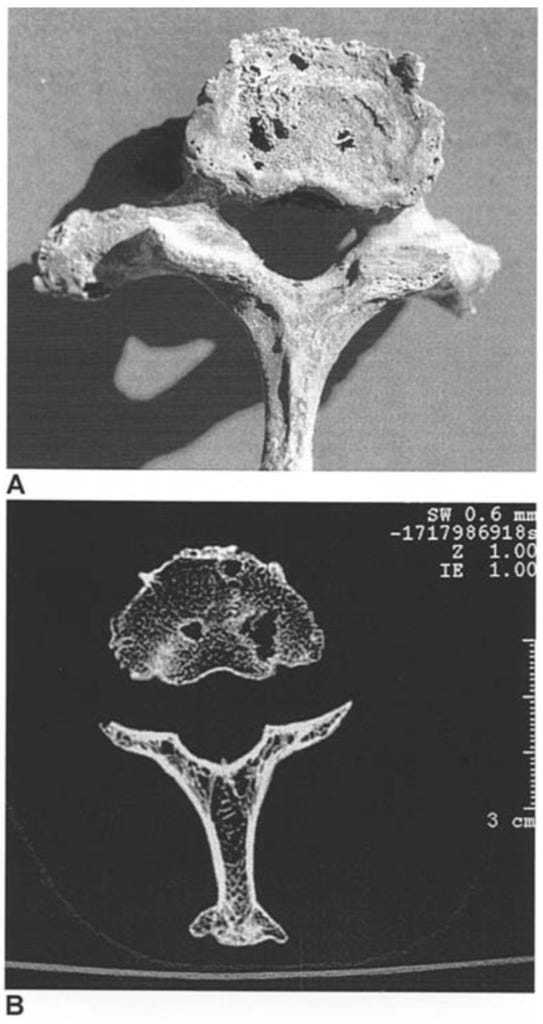
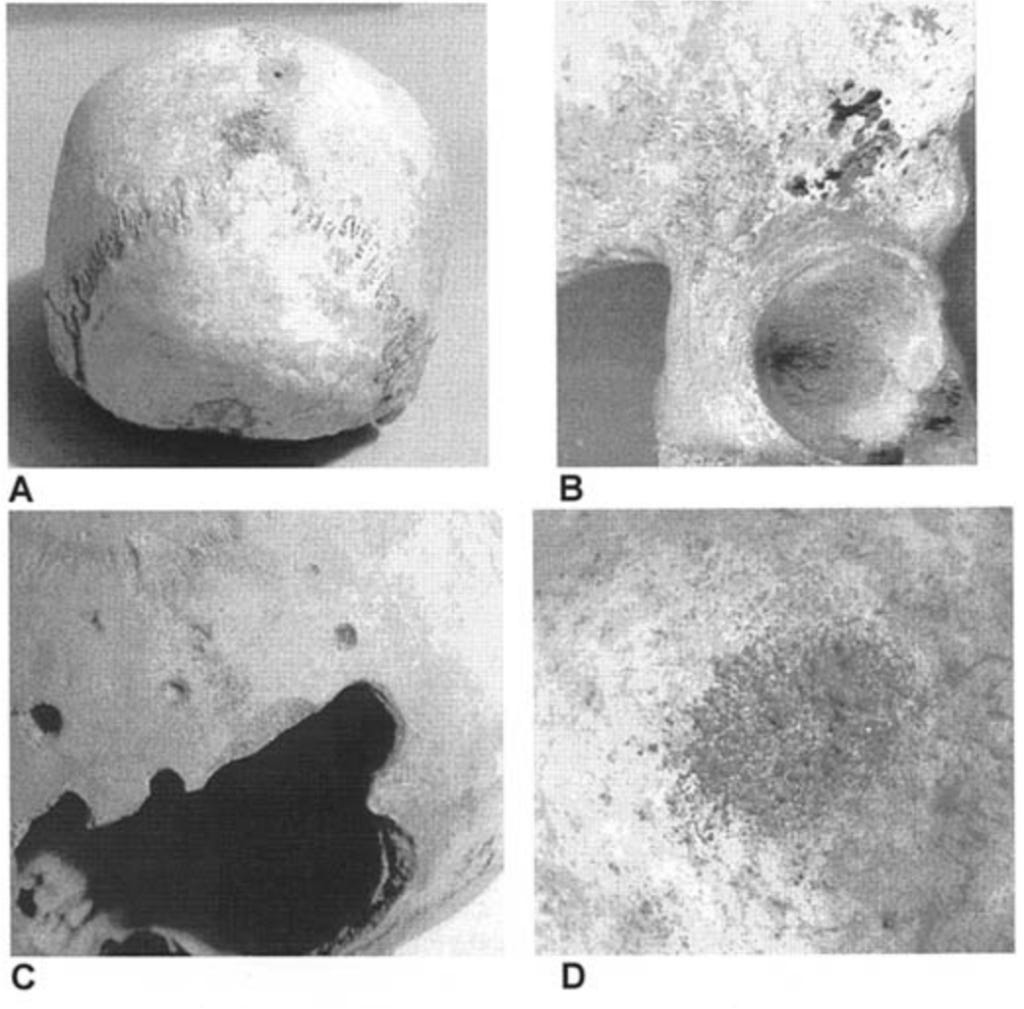
Talkin' bout cancer in my generation
Turning back to the JAMA article, the authors - two cancer epidemiologists from the National Cancer Institute - estimated cancer incidence trends in successive social generations, as follows:
The Greatest Generation (born from 1908 through 1927)
The Silent Generation (born from 1928 through 1945)
The Baby Boomers (born from 1946 through 1964)
Generation X (born from 1965 through 1980).
They used registry data from the Surveillance, Epidemiology, and End Results (SEER) Program, involving a total of 3.8 million US individuals who were diagnosed with invasive cancer between the ages of 35 and 84, during the years 1992-2018 (that is, before a large chunk of the population was subjected to an experimental gene therapy with multiple mechanisms of cancer promotion that has been associated with statistically significant increases in cancer mortality rates in Japan, Europe, Australia, and the US).
The figures from the study tell the tale - a sharp uptick in cancer incidence in Gen Xers of both sexes and all four ethnicities, except for Asian or Pacific Islander males. Note the dramatic decline in cancer rates in Greatest and Silent Generation males. The rise in cancer rates in Gen X females is particularly striking:
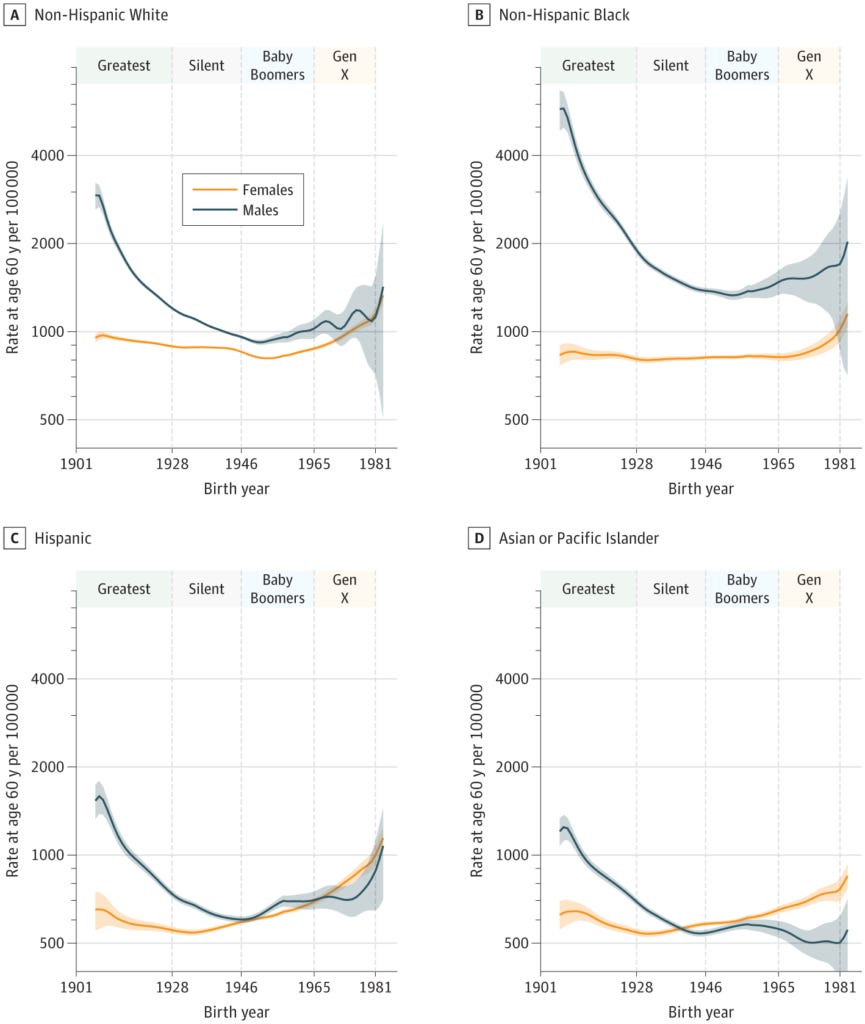
The comparison of cancer rates in each generation to those in the previous generation/s is quite startling. In each plot, the blue dot represents the older generation and the orange arrowhead, the younger generation. If the orange arrowhead is to the left of the blue dot, that means a lower cancer rate in the younger generation. Conversely, if the orange arrowhead is to the right of the blue dot, the younger generation has a higher cancer rate than the older. 'Proxy parents' refers to the two generations before the generation under consideration; the Baby Boomers mostly had Greatest and Silent Generation parents, while Gen X had Silent Generation and Baby Boomer parents:
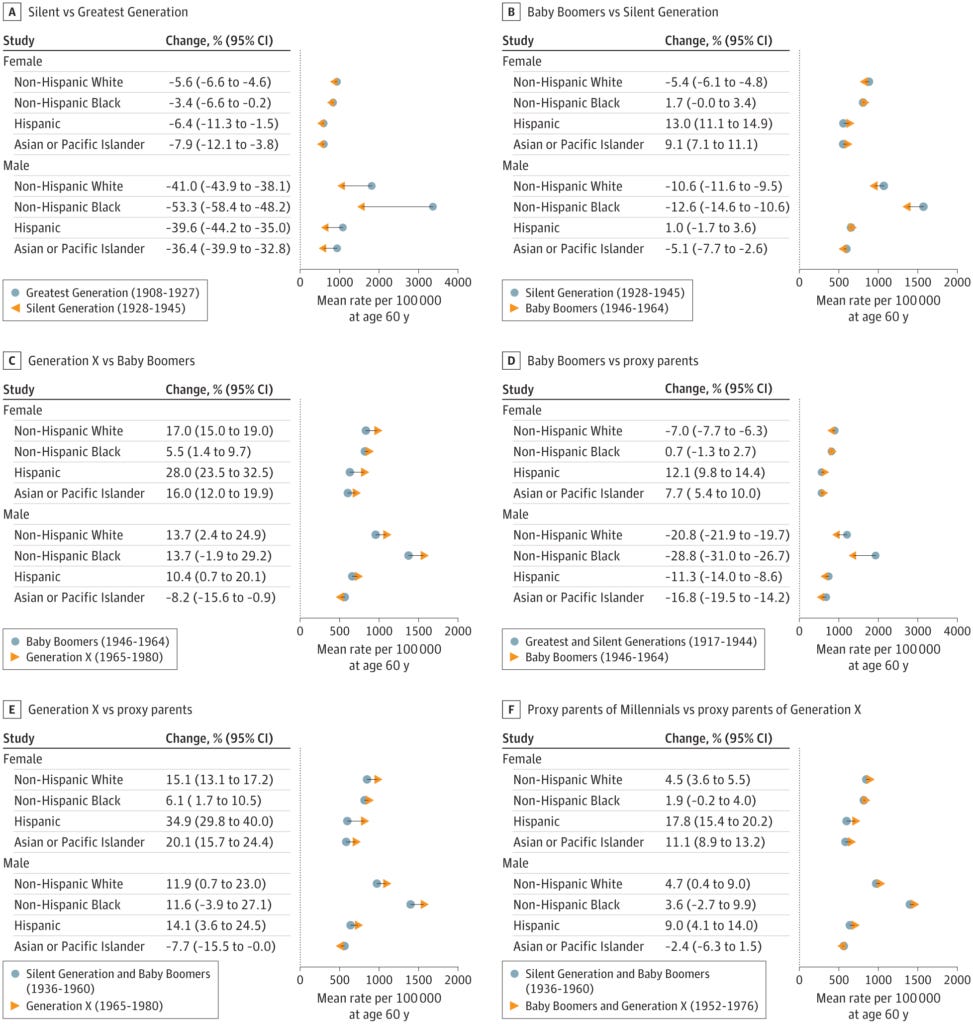
While an individual born in 1950 could expect to live a full 19 years longer than one born in 1900, those born in 2000 have only nine years of additional life expectancy compared to those born 50 years before them. The dramatic gains in life expectancy of the first half of the twentieth century had petered out by the time the first Generation X kids were born in 1965. So increased lifespan cannot explain the decline in male cancer rates in the Greatest and Silent Generations, nor the fact that Gen Xers have a higher lifetime prevalence of cancer than their Silent Generation and Baby Boomer parents, and a steeper rise in cancer incidence than any prior generation born in the twentieth century.
Overdiagnosis?
The authors of the study acknowledge that one contributing factor to the dramatic rise in cancer incidence in younger generations is the proliferation of diagnostic technology that detects indolent cancers (which would be better left undetected because they are slow-growing and unlikely to metastasise). The influence of overdiagnosis is especially evident in the steep rise in rates of thyroid and kidney cancers (which have low mortality). Likewise, screening colonoscopy may partially account for the increased incidence of colon cancer, as lesions which may not have developed into clinical significance, are still diagnosed as cancer. But neither overdiagnosis nor improved diagnosis account for the uptick in pancreatic cancer - which is still almost invariably detected at a late stage - in White Gen X women:
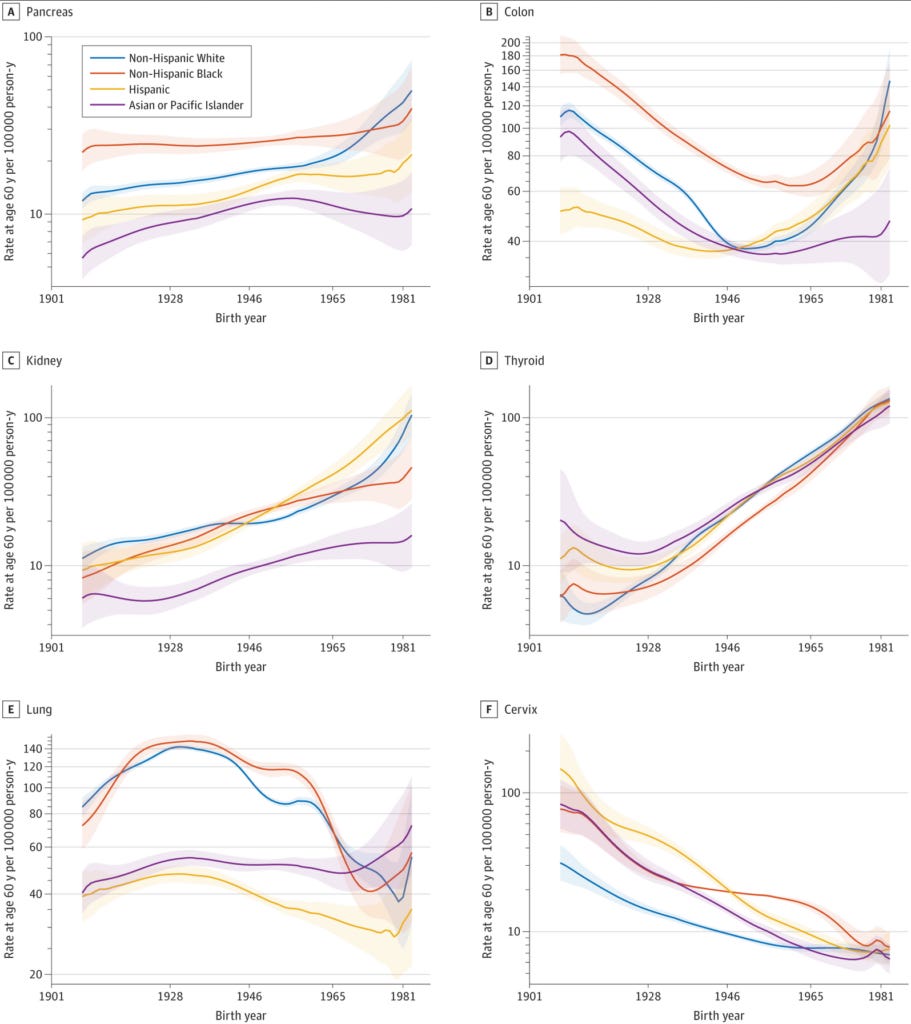
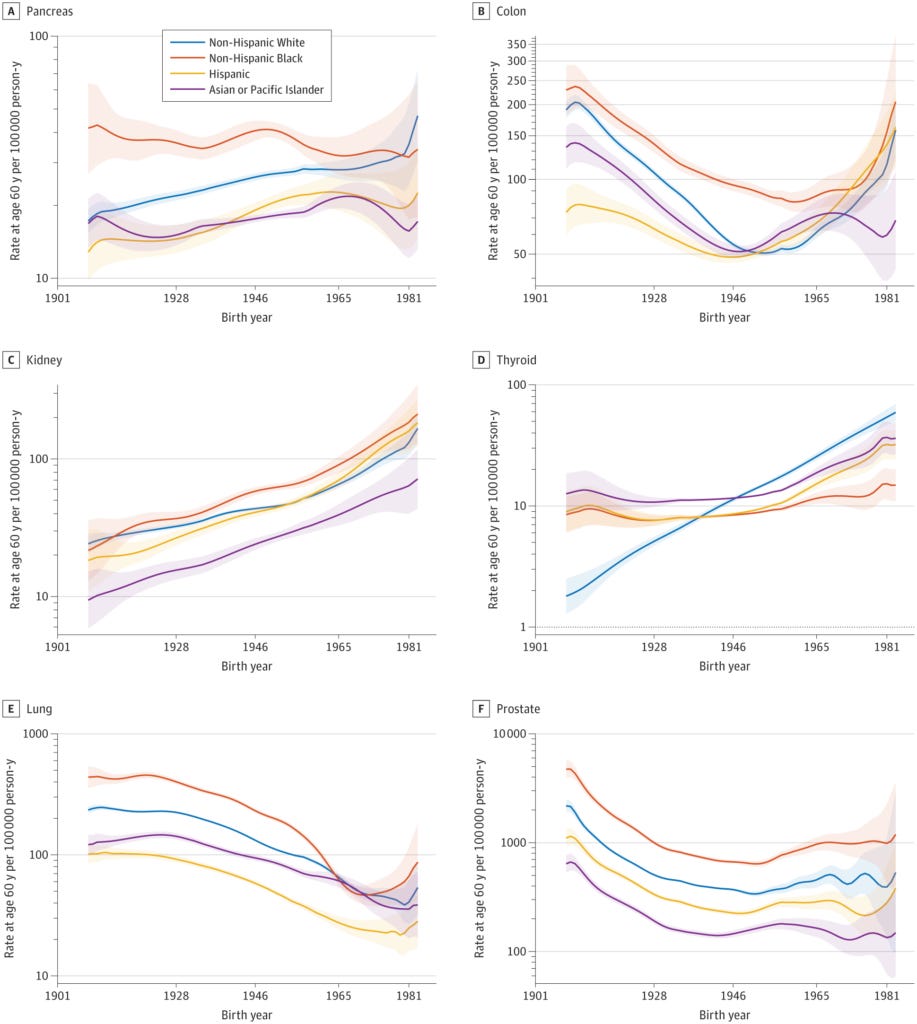
'Cancer' is not a unitary disease
It's readily apparent from the above figures, that the risk factors for individual cancers vary enormously, and the following figure makes it even more obvious that some types of cancer became less frequent in subsequent generations (blue square to the left of the vertical line), others became more common (blue square to the right of the line); if the horizontal line crosses the vertical, the result is not statistically significant:
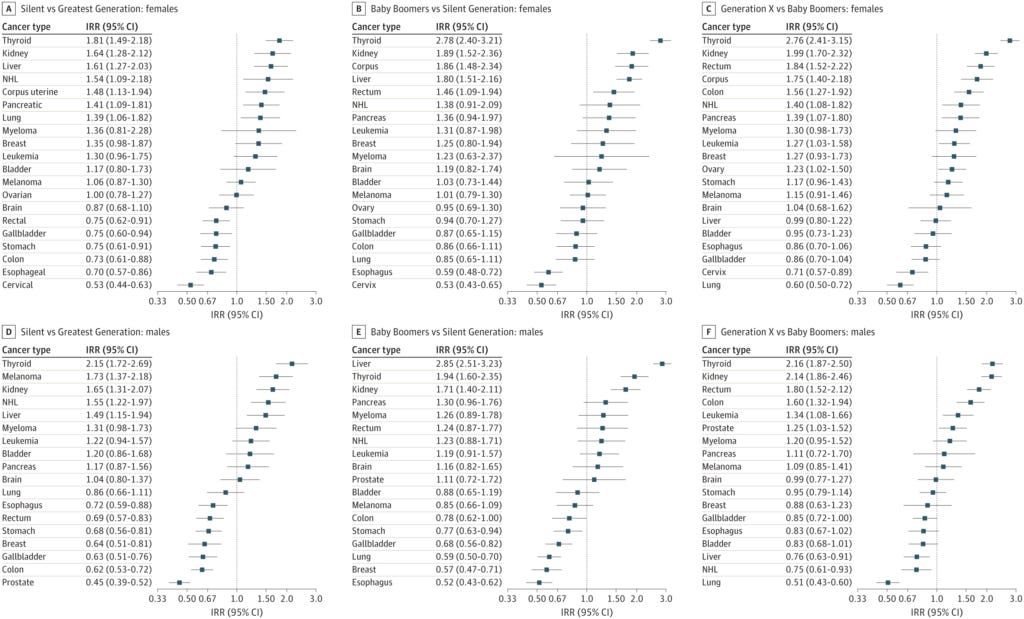
It's long been known that secular trends in exposure to particular carcinogens lead to fluctuating incidence of the cancers they cause. For example:
An epidemic of scrotal cancer plagued eighteenth and nineteenth century chimney sweeps, until child labour laws prohibited prepubescent boys (mostly orphans) from being forced into this dirty and dangerous trade;
Formerly astronomically high stomach cancer rates plummeted once refrigeration replaced pickling as the chief means of preserving food; and
Distinct sex differences in trends in lung cancer rates reflect the much later mass adoption of cigarette smoking by women, compared to men.
Which carcinogens have Gen X had higher lifetime exposure to, than previous generations? Here are a few:
Obesity. While childhood obesity, and even overweight, was comparatively rare among Gen Xers, my generation sure did pork up over time. A 2014 study comparing National Health Survey data from Australian Baby Boomers and Generation X, when both generations were aged between 25–44 years, found that Gen Xers were more than twice as likely to be overweight/obese and nearly twice as likely to have diabetes, than Boomers were at the same age. Any excursion to a shopping centre will provide ample proof that most people these days are rather too well-upholstered for their own good, but Gen Xers have been fatter for a greater part of their lifespan than Boomers.
Sedentary lifestyles. Once again, although our childhoods were far more physically active than those of Millennials and Gen Zs, Gen X got lazier over time; currently, Baby Boomers are Australia's most active generation.
Ultraprocessed food. While the 1950s ushered in the era of 'convenience foods', the replacement of home-cooked meals with ultraprocessed slop dramatically accelerated in my generation. I knew plenty of kids whose school lunch consisted of a Twistie roll1 and a can of Coke, and whose mothers thought nothing of picking up 'dinner' from a fast food restaurant on the way home from work. (The very first McDonald's outlet in Australia opened in 1971, the year of my birth; my Silent Generation parents thought it was disgusting slop and hence, I never tasted McDonald's food until I was well into my teens and earning my own money. It turns out I didn't miss much.)
Toxic chemicals of every description. The JAMA study mentions poly- and perfluoroalkyl substances (PFAS) as concerning exposures in relation to cancer risk. But these are just one category of suspected or established carcinogenic chemicals that are in the air we breathe, the water we drink, the food we eat, the personal care products we slather on our hair and skin, the furniture and soft furnishings in our homes, and the medications and vaccines we take.
The oldest Gen Xers will be hitting 60 next year, and as we age up, my generation's already high cancer rates are poised to explode... especially since so many of us took that experimental gene therapy which, according to a leading oncologist, is causing cancer recurrences in patients in remission, and highly aggressive and rapidly-spreading cancers in people with no previous history:
As bad as Gen X's future looks, as the authors of the study point out, subsequent generations are likely to be in even worse shape:
"The rate of leading cancers appears to be as high or higher in the proxy parents of the Millennials than the proxy parents of Generation X. Therefore, if the Millennials’ cancer experience follows the estimated trajectory of their proxy parents, cancer incidence in the US could remain unacceptably high for decades to come."
Cancer Incidence Trends in Successive Social Generations in the US
Yikes - that's scary! What should you do to reduce your risk of cancer - whether you're a Gen Xer, or any of the generations that came before or after? Well, there's a lot of cancer prevention advice put out there by self-appointed 'health influencers', and much of it is completely contradictory. I'll be dissecting one particular strand of that advice - low carbohydrate diets - in next week's post.
For information on my private practice, please visit Empower Total Health. I am a Certified Lifestyle Medicine Practitioner, with an ND, GDCouns, BHSc(Hons) and Fellowship of the Australasian Society of Lifestyle Medicine.
A Twistie roll, for those not in the know about this Australian culinary masterpiece, consists of a packet of Twisties smooshed into a buttered white bread roll. A quick glance at the Twisties ingredients list - Cereals (Corn, Rice), Vegetable Oil, Maltodextrin, Salt, Whey Powder (Milk), Sugar, Flavour , Chicken Fat, Hydrolysed Vegetable Protein (Soy), Flavour Enhancers (621, 635), Milk Salt (Potassium Chloride), Onion Powder, Garlic Powder, Spice (Turbo, Natural Colour (Turmeric) - confirms that it has all the necessary food groups for you to get fat and sick, and possibly develop cancer. Enjoy.





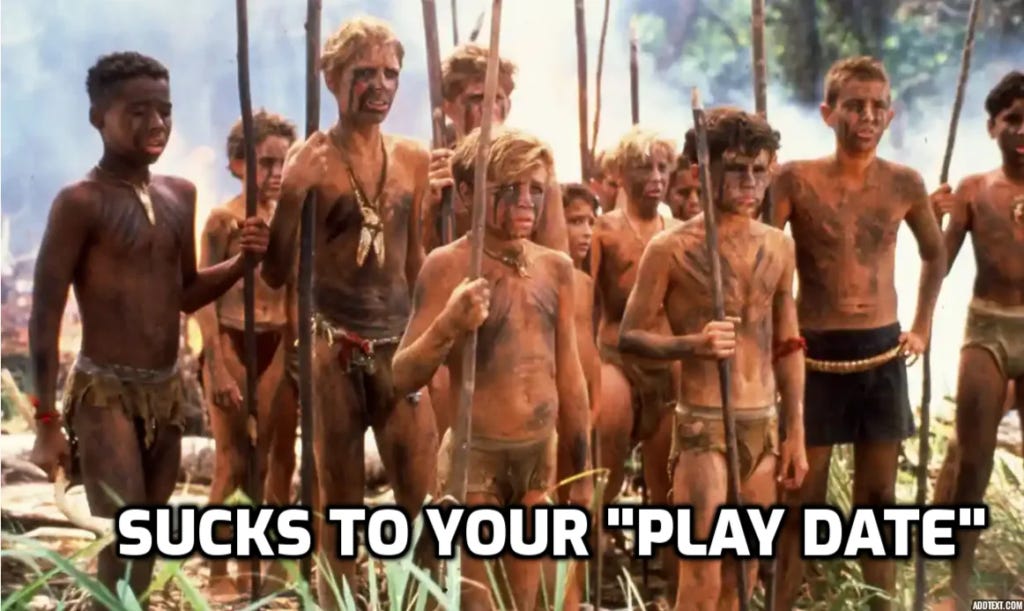
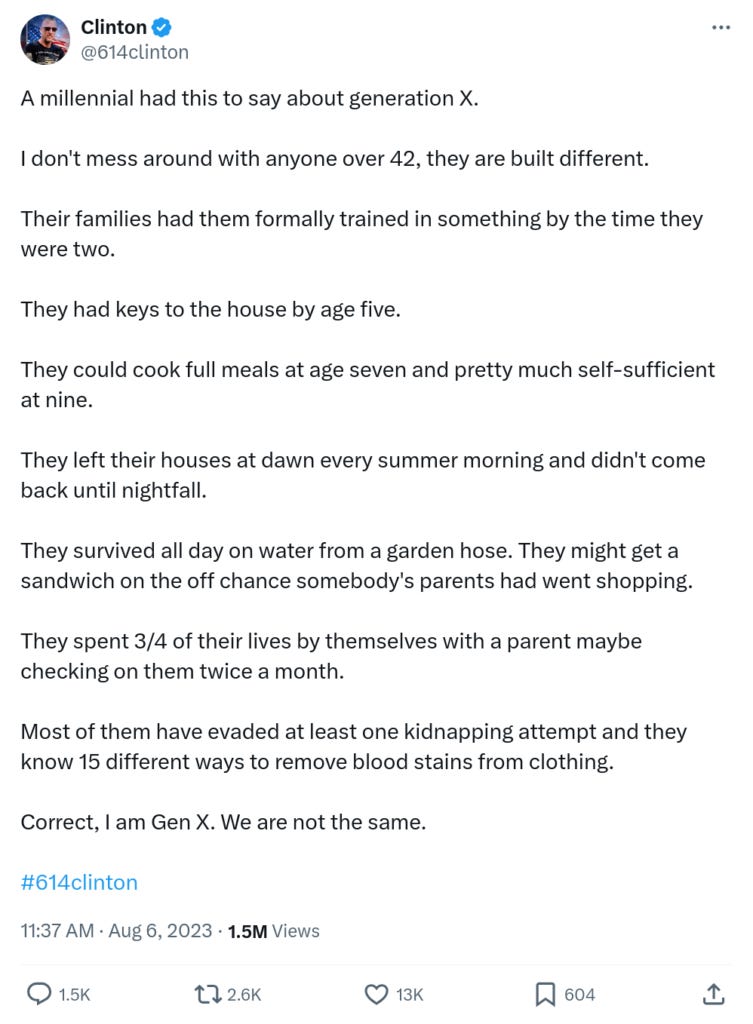


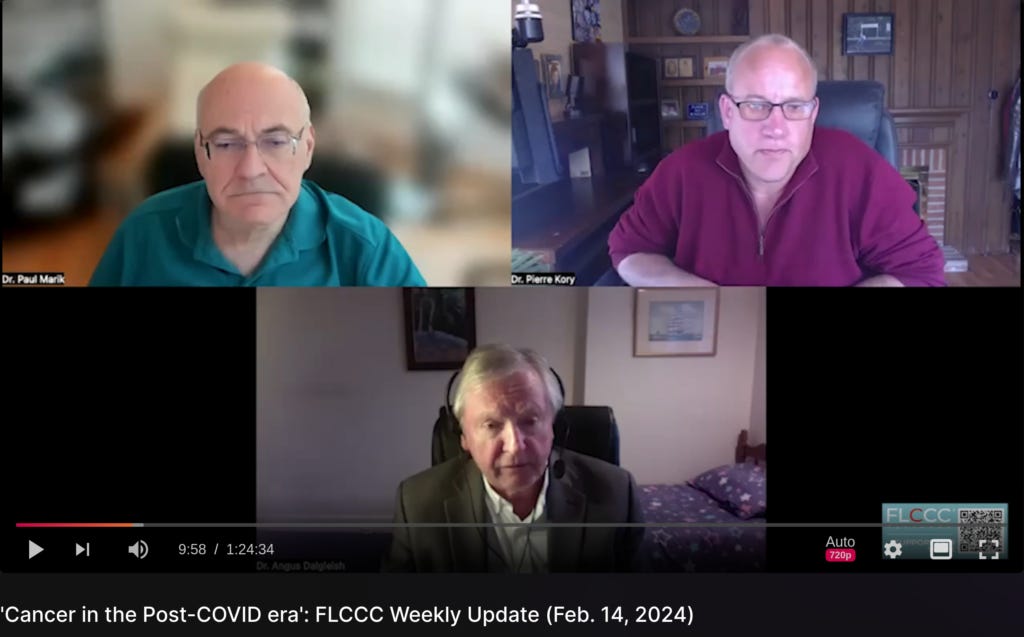
Wow!
That was another great and interesting post Robyn.
I'm pleased I just snuck into the silent generation (1944),crikey that's 80 trips around the sun!
I used to ride my bike,through the bush,to primary school when I was about11,and remember loving my freedom.
One day on my way home two older girls,about 13,jumped from behind a tree and pushed me off my bike,off with my shorts and tried to have their way with me.I had no idea what was going on and when there was no sign of an erection ( I was petrified and had probably never had one anyway) they gave me a Chinese burn on both my wrists and with a few F bombs left me.
I can't remember how I explained the wrist burns to my Mum.
I kept riding to school with no further encounters, I guess they put me in the "too stupid" category.
Yes Robyn,I will have another try at the backwards somersault off Moona Moona creek bridge,which dismays my wife but,that's just the way it is 🤣.
Thanks Robyn,
Davo 😊.
Food quality has been the changing factor for generations. Our food now is NOT the same as food from pre-20th century mass production. The "modern" application of chemicals has inherently changed the nutritive quality and biological impact of grains, fruit, vegetables and even animal foods that have been on earth since the beginning of time. Analyzing diets of people before 20th century can not be an "apples to apples" comparison. Human interference via Chemical alteration of natural, earthly food as it was created has skewed health outcomes. The chemical alterations are essentially a "wolf in sheep's clothing". Something bad arriving secretly with something good.